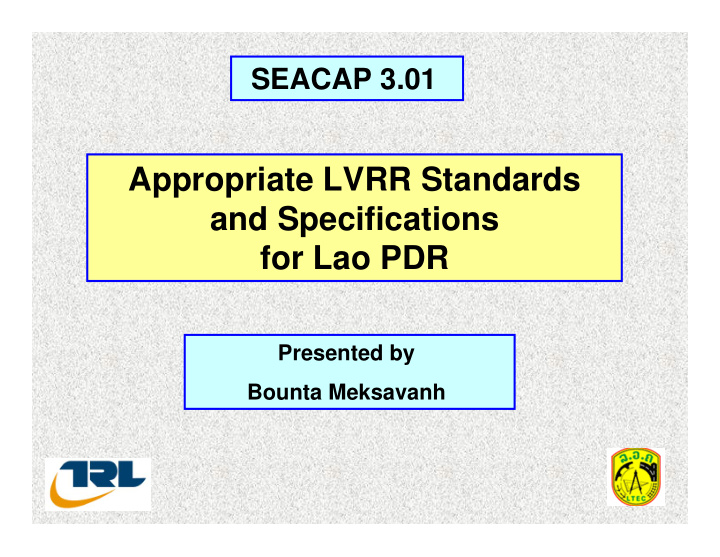



SEACAP 3.01 Appropriate LVRR Standards and Specifications for Lao PDR Presented by Bounta Meksavanh 1
Key Aims The development & mainstreaming of appropriate rural road standards based on road function & available resources Formal STANDARDS are essential to provide the framework within which resource-based LVRR options can be mainstreamed with appropriate technical SPECIFICATIONS . 2
3 The Requirement
Key Issues Designs or options need to meet road task requirements (Task-Based) � Designs based on available human; budget; materials and construction resources (Resource-Based) � Designs appropriate to the road environment (Environmentally Optimised ) 4
Standards: Three Key Points � Compatible with Lao PDR Road Law � Based firmly on the road function NOT administration � Falling within the Low Volume Rural Road traffic envelope 5
LVRR Envelope The LVRR classification Upper axle load of 4.5T Upper limit of an equivalent ADT of 150 motor vehicles Traffic analysis based on assessment of key vehicles 6
Key Function Issue: Safety LVRRs are very likely to carry mixed traffic; from light trucks to pedestrians. Safety is a key issue in mixed traffic environment. Need to keep traffic slow (40km/hr) rather than designing for maximizing speed. Wider shoulders is also an option 7
Appropriate Specifications The use of local construction materials is essential: specifications and design must suit the available materials. Specifications and design options aimed at an Environmentally Optimised Design (EOD) and Spot Improvement strategy; best use of available budget resources 8
Delivered The key delivered outputs are: � A new LVRR Classification with a suitable set of Geometric Specifications � A matrix of pavement and surfacing design options � A guideline document associated with (1) and (2) above. 9
Key Pavement Outcomes 1: Reduction in pavement thickness 2: Allows variation in material quality 3: Use of capping layer material 10
Application Framework Whole-Life Costed & Environmentally Optimised Design (EOD) Utilising the available resources of budget and materials in the most cost-effective manner. 11
12 EOD: Spot Improvement to Whole Length Improvement
13 Regional variation in Design Exceptions Specifications – Standards &
14 Research into Practice through appropriate Standards and Specifications
Recommend
More recommend